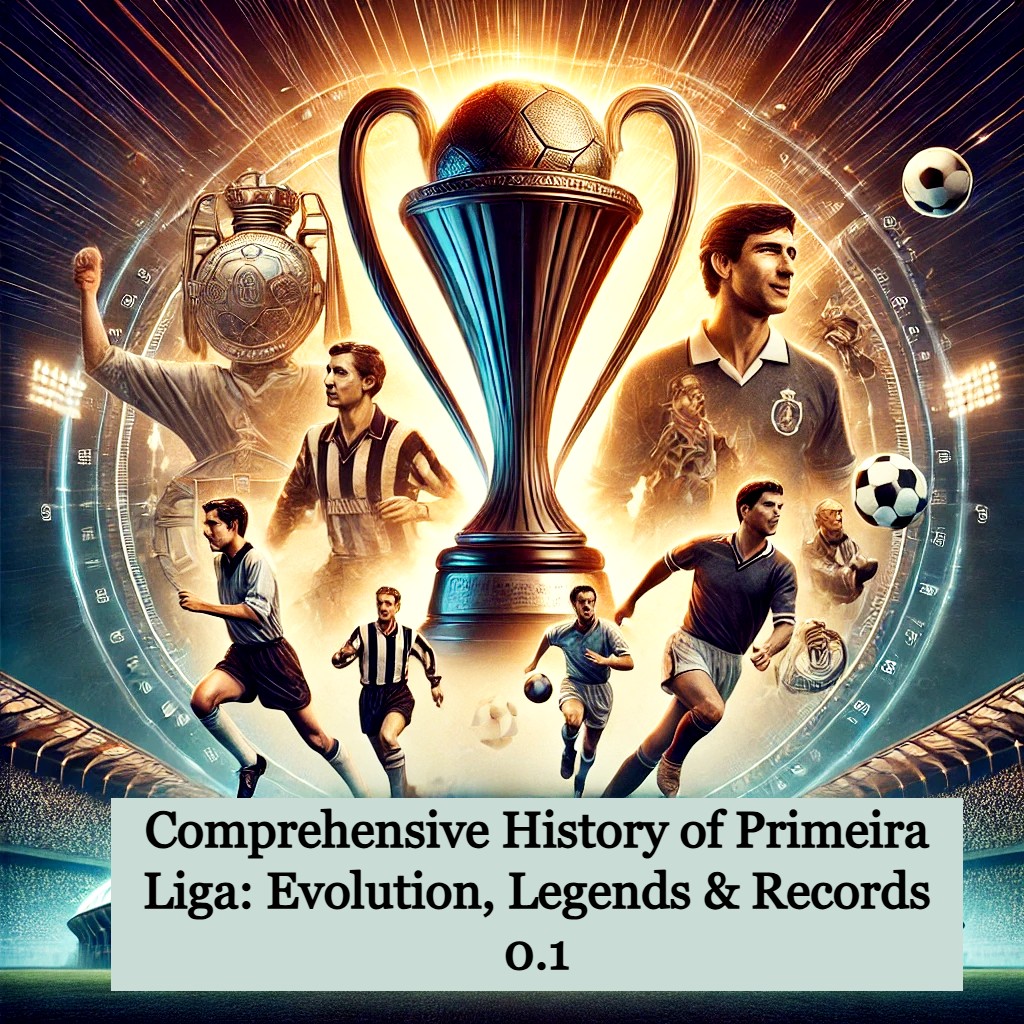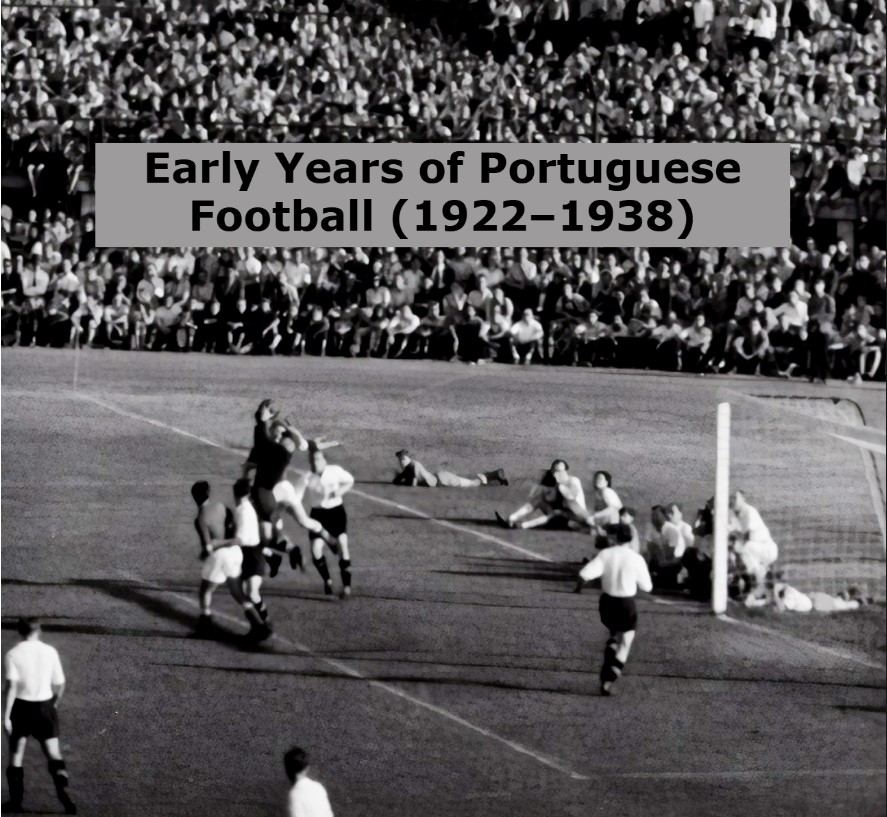
Introduction: Comprehensive History of Primeira Liga
The Primeira Liga stands as Portugal’s premeir professional football division, has earned a reputation as one of Europe’s most prestigious leagues. Known for its technical excellence, tactical discipline, and ability to nurture top-tier talent, it has played a key role in shaping Portuguese football.
Since its inception in 1934, the league has evolved significantly, expanding in size, increasing in competitiveness while producing clubs that have shined in UEFA Champions League and Europa League tournaments. While the “Big Three”— SL Benfica, FC Porto, and Sporting CP—have largely dominated, other clubs have also enjoyed moments of glory.
This comprehensive analysis examines the Primeira Liga’s evolution, highlighting its history, structure, and lasting impact, tracing its journey from its origins to its current status among Europe’s elite leagues.
Early Years of Portuguese Football (1922–1938)

Pre-League Era
Football was introduced to Portugal in the late 19th century, influenced by British expatriates and Portuguese students returning from England. In its early days, matches were informal, with clubs primarily competing in regional tournaments rather than a unified national league.
The fist attempt at a nationwide football competition came in 1922, The Campeonato de Portugal, was established. This knockout-style competition, similar to the modern Taça de Portugal, determined the national champion. However, as it lacked a league-based structure, it did not provide a season-long ranking of teams.
The Birth of a National Football League

By the early 1930s, Portuguese football had gained significant popularity, making the need for a structured national league more evident. Up until then, football remained largely regionalized, with the Campeonato de Portugal serving as the country’s main tournament. However, as a knockout competition, it did not function as a true league system, prompting discussions about the creation of a more comprehensive format.
In 1934, the Portuguese Football Federation (FPF) introduced the Campeonato da Liga da Primeira Divisão, an experimental league designed to determine Portugal’s best football team using a round-robin format, allowing teams to compete across a full season rather than in an elimination-style tournament. Unlike the Campeonato de Portugal, which operated as a cup competition, the league provided a more consistent assessment of each club’s performance.
The league’s first edition featured eight teams, bringing together some of Portugal’s most prominent clubs. FC Porto won the inaugural championship in the 1934-35 season, making the beginning of a new era in Portuguese football. However, despite this success, the Campeonato de Portugal remained the official tournament for determining the national champion, maintaining its prestige within the Portuguese football.
However, in 1938, the growing influence and structure of the league led to a landmark decision. The Campeonato da Liga da Primeira Divisão was officially renamed as the Campeonato Nacional da Primeira Divisão, establishing it as Portugal’s top football division. Consequently, the Campeonato de Portugal was relegated to a secondary role and later transformed into the modern-day Taça de Portugal (Portuguese Cup).
This transformation solidified the Campeonato Nacional da Primeira Divisão as the primary competition for determining Portugal’s best football club, laying the groundwork for the modern Primeira Liga. Over the decades, the league flourished, attracting world-class talent and strengthening Portugal’s status as a formidable presence in European football.
Expansion and “Big Three” Dominance (1940s-1970s)
League Expansion and Nationwide Growth
as football continued to grow in popularity, the Primera Liga expanded multiple times to include more clubs:
- 1939: League size increased to 10 teams
- 1941: Further expansion to 12 times
- 1946: Grew to 14 teams
These changes allowed clubs from different regions to participate, strengthening national interest and competitiveness in Portuguese football.
The Emergence of the “Big Three”
Between the 1940s and 1970s, three clubs rose to dominance, shaping the landscape of Portuguese football for decades:
- SL Benfica
- FC Porto
- Sporting CP
Collectively known as the “Big Three,” these clubs won the vast majority of league titles and established their dominance.
- SL Benfica emerged as the most successful club of the era, securing multiple championships in the 1950s and 1960s, largely thanks to the incredible performances of legendary striker Eusébio.
- Sporting CP enjoyed significant success in the 1940s and 1950s, led by the prolific goal scorer Fernando Peyroteo.
- FC Porto would later rise as a powerhouse from the 1980s onward, mounting a serious challenge to Benfica’s supremacy.
Benfica’s Golden Era in Europe
The 1960s marked a historic period for SL Benfica, as the club cemented its status among Europe’s elite. Under the guidance of legendary manager Béla Guttmann, Benfica achieved back-to-back victories in the European Cup titles (now the UEFA Champions League) in 1961 and 1962,defeating Barcelona and Real Madrid, respectively.
Benfica’s triumphs on the European stage not only brought prestige to the club but also enhanced Portuguese football’s global reputation, with stars like Eusébio gaining global recognition for their talent and contributions to the sport.
Professionalization and European Success (1980s–2000s)
The Porto Dominance Begins
The 1980s and 1990s saw a shift in power within Portuguese football, with FC Porto establishing itself as the dominant club. Their greatest achievement came in 1987, when they secured the UEFA Champions League trophy after a memorable victory over Bayern Munich in the final.
During this period, Porto consistently won domestic league titles and built a reputation for their disciplined tactical approach, making them a formidable contender in European competitions.
Boavista’s Historic League Victory
During the 1999–2000 season, Boavista FC made history by becoming just the second club outside the “Big Three” to win the Primeira Liga title. Prior to them, only C.F. Os Belenenses, in 1945–46, had managed to break the long-standing dominance of Benfica, Porto, and Sporting CP in Portuguese football.
Rebranding and Financial Growth
In 1999, the league was officially rebranded as the Primeira Liga, marking a new era for Portuguese football. Over the years, various sponsorship deals have led to different league names, including:
- Liga betandwin.com
- Liga Sagres
- Liga ZON Sagres
- Liga NOS
- Liga Portugal Bwin
- Liga Portugal Betclic (current name)
These sponsorships have significantly boosted the league’s financial resources, allowing clubs to strengthen their squads and develop better facilities.
Modern Era and Global Recognition (2010s–Present)
Portuguese Clubs Shine in European Tournaments
Portuguese clubs have continued to make their mark in Europe:
- FC Porto secured their second UEFA Champions League trophy in 2004, guided by José Mourinho.
- SL Benfica reached the Europa League finals in 2013 and 2014, though they finished as runners-up in both attempts.
- Sporting CP celebrated a historic Primeira Liga title win in 2020–21, ending a 19-year championship drought.
These accomplishments have played a key role in elevating the global reputation of Portuguese football.
Primeira Liga: A Breeding Ground for Stars
The Primeira Liga has earned a reputation as a top-tier talent development league, producing world-class players who have gone on to thrive in Europe’s biggest clubs:
- Cristiano Ronaldo (Sporting CP → Manchester United)
- Bruno Fernandes (Sporting CP → Manchester United)
- João Félix (Benfica → Atlético Madrid)
- Bernardo Silva (Benfica → Manchester City)
Portuguese clubs have successfully implemented a sustainable model centered on scouting, developing, and selling top-tier talent for substantial transfer fees.
Primeira Liga: Competition Format and Structure
The Primeira Liga comprises 18 clubs, each playing 34 matches per person in a double round-robin system, meaning every club competes home and away against each opponent.
- The top teams earn qualification spots for the UEFA Champions League and Europa League.
- The bottom two teams are relegated to the Segunda Liga.
- The team finishing third-last must compete in a promotion/relegation playoff to retain their place in the league.
This format ensures highly competitive football, with clubs constantly striving for European qualification or battling to avoid relegation.
Primeira Liga: Structure and Competition Format
The Premeira Liga, also known as the Liga Portugal, is Portugal’s premeir professional football competition, featuring 18 teams that complete for the league title, spots in European tournaments, and to avoid relegation to the second division.
Each club plays 34 matches in a double round-robin format, facing every opponent twice—once at home and once away. This format guarantees a fair and balanced season, testing teams across different venues. The season typically spans August to May, with matches scheduled primarily on weekends, alongside occasional midweek fixtures to accommodate a packed calendar.
AT the top of the standings, clubs fight for coveted European spots. The league winners and runners-up gain direct entry into the UEFA Champions League group stage, while the third-placed team must navigate the qualifying rounds. The fourth and fifth-placed teams generally secure places in the UEFA Europa League or UEFA Europa Conference League, depending on Portugal’s UEFA coefficient ranking. These European places add extra significance to the competition, motivating teams to push for strong league finishes.
At the lower end of the table, clubs battle to avoid relegation. The teams 17th and 18th place are automatically sent down to the Segunda Liga, while the 16th-placed team enters a promotion/relegation playoff against a top Segunda Liga club. This playoff is often one of the most intense moments of the season, as clubs battle for survival in the top flight.
With high stakes in every section of the table, the Primeira Liga offers a season full of excitement, from the title race and European qualification battles to the fight against relegation. While the “Big Three”—Benfica, Porto, and Sporting CP— have traditionally dominated, emerging clubs continuously push to challenge their supremacy, keeping the Primeira Liga as one Europe’s most exciting leagues.
Global Reach and Cultural Significance of the Primeira Liga
The Primeira Liga is a cornerstone of Portuguese sports culture and holds signnificant influence in global football. Clubs in the league boast passionate fan bases, and their reach extends beyond Portugal to Portuguese-speaking nations such as Brazil, Angola, and Mozambique, where the league enjoys widespread support.
Beyond its club competition, Portugal has produced some of the world’s most renowned football managers. Managers like José Mourinho, André Villas-Boas, and Rúben Amorim have made their mark on top European clubs, showcasing the Primeira Liga’s impact in developing world-class footballing minds.
Final Thoughts
Since its foundation in 1934, the Primeira Liga has grown into one of Europe’s top football leagues, known for developing elite players and providing a stage for intense competition. It continues to be a hotbed for talent development, nurturing future football stars while delivering high-intensity matches that captivate fans worldwide.
Despite the long-standing dominance of Benfica, Porto, and Sporting CP, have long dominated, emerging challenges and ambitious clubs ensure the league remains exciting and unpredictable. With a steadfast commitment to excellence and innovation, the Primeira Liga is set to remain a major force in global football for the foreseeable future.
Recommend:
Stay updated with the La Liga: Latest News, Match Highlights, Standings, Transfers & Injury Updates (February 2025)! Get match results, current standings, transfer updates, injury reports, and managerial changes for February 2025. Check out now!
Check out our The Incredible Rise of La Liga: A Fascinating History & Formation The Evolution of La Liga! Dive into the league’s captivating history—from its early days in 1929 to becoming a football giant. Discover legendary teams, unforgettable moments, and key milestones. ⚽ #LaLiga #SoccerHistory
